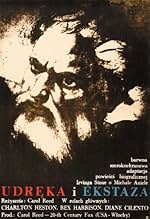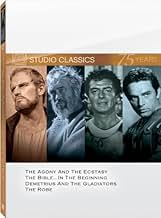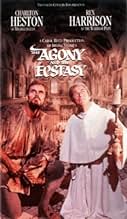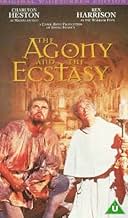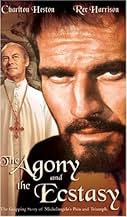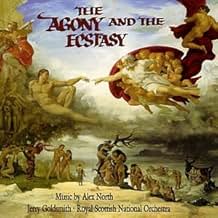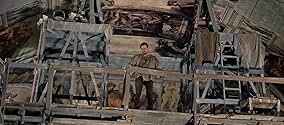NOTE IMDb
7,2/10
8,5 k
MA NOTE
Michel-Ange est chargé par le pape Jules II de peindre les fresques du plafond de la Chapelle Sixtine. Le peintre génial supporte mal le comportement despotique du pape. L'affrontement entre... Tout lireMichel-Ange est chargé par le pape Jules II de peindre les fresques du plafond de la Chapelle Sixtine. Le peintre génial supporte mal le comportement despotique du pape. L'affrontement entre les deux grands hommes est inévitable.Michel-Ange est chargé par le pape Jules II de peindre les fresques du plafond de la Chapelle Sixtine. Le peintre génial supporte mal le comportement despotique du pape. L'affrontement entre les deux grands hommes est inévitable.
- Réalisation
- Scénario
- Casting principal
- Nommé pour 5 Oscars
- 3 victoires et 9 nominations au total
Fortunato Arena
- Pope's Bodyguard
- (non crédité)
Lars Bloch
- Baron Von Silenen
- (non crédité)
Angelo Boscariol
- Papal Guard
- (non crédité)
Calisto Calisti
- Physician
- (non crédité)
Amerigo Castrighella
- Quarry cart assistant
- (non crédité)
Anita Ceccotti
- Woman Under the Chapel
- (non crédité)
Enrico Chiappafreddo
- Tavern Customer
- (non crédité)
Avis à la une
"The Agony and the Ecstasy" is the story of Michaelangelo and his painting of the Sistine Chapel at the behest of Pope Julius II, a warrior and Patron of the Arts.
But it's really about so much more - the connection between art and the artist, faith, will, and the quest for perfection. Most of all, it's about the complicated relationship of two determined men, Michaelangelo and Pope Julius, which is adversarial and even violent.
The color and scenery in this film are truly beautiful, but I'd love to see a restored print, as I imagine the colors would even be richer.
Charlton Heston is a convincing and strong Michelangelo in what may be his best performance. It's buoyed by the magnificent work of Rex Harrison as Julius II. The two spark one another, and the result is an exciting screen teaming. There is hatred, resentment, a battle of wills, love and admiration between them, the agony and ecstasy of connecting with another, as Diane Cilento says in the film. She plays a woman in love with Michaelangelo. He explains that he cannot love her because of the commitment he has made to his true love, his art. The book hints at Michaelangelo's homosexuality, and it's covered with one line. After Michaelangelo says that he cannot match her feelings, he looks at a sketch of a nude man. "And it's not that either," he says.
Many scenes stick out. The somewhat hokey one in the mountains, when Michaelangelo looks at the heavens and receives his inspiration is nevertheless a gorgeous scene; the incredible scene when Michaelangelo discovers the Pope alone at night with a candle studying the ceiling is perhaps the best, as Michaelangelo explains his concept of God and faith. And the last scene between the two men is unforgettable.
There is a documentary about Michaelangelo and his work before the movie begins. A magnificent film. Don't miss it.
But it's really about so much more - the connection between art and the artist, faith, will, and the quest for perfection. Most of all, it's about the complicated relationship of two determined men, Michaelangelo and Pope Julius, which is adversarial and even violent.
The color and scenery in this film are truly beautiful, but I'd love to see a restored print, as I imagine the colors would even be richer.
Charlton Heston is a convincing and strong Michelangelo in what may be his best performance. It's buoyed by the magnificent work of Rex Harrison as Julius II. The two spark one another, and the result is an exciting screen teaming. There is hatred, resentment, a battle of wills, love and admiration between them, the agony and ecstasy of connecting with another, as Diane Cilento says in the film. She plays a woman in love with Michaelangelo. He explains that he cannot love her because of the commitment he has made to his true love, his art. The book hints at Michaelangelo's homosexuality, and it's covered with one line. After Michaelangelo says that he cannot match her feelings, he looks at a sketch of a nude man. "And it's not that either," he says.
Many scenes stick out. The somewhat hokey one in the mountains, when Michaelangelo looks at the heavens and receives his inspiration is nevertheless a gorgeous scene; the incredible scene when Michaelangelo discovers the Pope alone at night with a candle studying the ceiling is perhaps the best, as Michaelangelo explains his concept of God and faith. And the last scene between the two men is unforgettable.
There is a documentary about Michaelangelo and his work before the movie begins. A magnificent film. Don't miss it.
I like historical films. Recently I watched three historical films all made in the early 1960s. These are 'El Cid', 'The Spartacus' and 'The Agony and The Ecstasy'. Of the three, I rate The Agony and the Ecstasy as the best. This film is based on the eponymous novel written by Irving Stone. I had read the book nearly a decade back and it was nice to see the film finally. The film is about the circumstances under which Michelangelo came to compose his famous frescoes in the Sistine Chapel of Rome in the 16th century. The Sistine fresco, the 'creation of man' has become almost an emblem for the artist. But not many know that Michelangelo painted the Sistine frescoes reluctantly, only because he was forced to do so by his patron, Pope Julius II. The film is about the war of wits between these two great men Pope Julius II is a warrior pope, a worldly Pope. His concern is to protect the papal states from being over run by warring European powers. For this he is willing to take up arms. The pope knows that the posterity wont remember him for his spiritual prowess or leadership. Therefore he want to leave great works of art as his legacy. He therefore hires Michelangelo to paint the ceiling of the Sistine Chapel. The artist is not very keen on painting and considers sculpture to be his true calling. He is also not willing to conform to the prevailing canons of artistic excellence. He feels constrained by the limits of time and money that is set. All the great moments of the film occur when the Pope and the Artist clash. It is a clash of ideas and world views: (1) Whether sculpture is a superior form of art as compared to painting; (2) Whether it is appropriate depict biblical figures in their raw humanity; (3) Whether it is moral for a man of god to take arms for his principles and so on. For me the finest scene in the film is where the Pope and the Cardinals come to see the frescoes and judge it as lacking in good taste. The Artist is forced to give a strong rebuttal and in the process he expounds the humanist philosophy of art. Shot in beautiful Technicolor, the film still looks spectacular. It is a visual and intellectual treat.
'Agony and the Ecstasy' is one heck of an attempt to be a big of a movie as possible. It's details the story of Pope Julius's commissioning of a reluctant Michelangelo to paint the roof of the Sistine chapel fer heaven's sakes!! It also two of the stars That Mattered In The 60's, Rex Harrison playing the Pope and Charlton Heston as Michelangelo! AND it runs for 2 and a half hours! I mean, this movie must mean something if they have a mini-biography of Michelangelo for the first 15 minutes, right? OK, despite it's too long running length, the movie is a fun sit through actually. It's not exactly a pompous costumed historical drama as it looks, sure there's a lot material covered here, but Heston and Harrison keep the story going quite well with their great portrayals here. I had seen this several years ago, and while Heston is good, it's Harrison who got my attention this time out, as his total control freak Pope character is quite entertaining to watch.
So again, a bit lengthy, but still entertaining.
So again, a bit lengthy, but still entertaining.
The Agony and the Ecstasy is the story of the creation of the Sistine Chapel Roof painting, the time and money it took while Pope Julius II was busy establishing his Papacy as a political force.
Back in those days the Pope was far more than the head of the Roman Catholic Church. He ruled a considerable piece of real estate in the center of the Italian peninsula that were called the Papal States. They varied in geographic size depending on how relatively strong the Pope or his enemies were at a given time. The Papal States were the last independent entity to join a united Italy in 1870.
The Borgias had been nibbling away at the Papal States for years and their triumph became complete when one of their's became Pope Alexander VI in 1491. When Giuliano Della Rovere became Julius II in 1503 succeeding Alexander VI he had it in mind to reclaim the states from the Borgias and their backer the French monarchy. Those are the folks you see Rex Harrison fighting at the beginning of the film.
In fact Harrison's identity as the warrior Pope is made clear right at the beginning of the film when after we see this figure on a white horse killing some foes in battle, he takes off his helmet and some attendees put his papal vestments right over his armor.
But Julius II wanted to be known as a patron of the arts as well as the warrior Pope. His uncle Pope Sixtus VI had built the Sistine Chapel which is today the personal chapel of the papal residence. According to Wikipedia its dimensions are exactly what the Bible lays down as the dimensions King Solomon built his temple. But who knows what Solomon had decorating his roof.
It's a big bare spot and who to fill it with something good. Julius II decided on Michelangelo Buonarrati who's got quite a resume of creativity to recommend him even though it's mostly sculpture.
The film is the story of the creative differences between Michelangelo and Julius. Michelangelo is knowing he's created something for the ages, but he won't see the big picture of the here and now of Renaissance European politics which Julius II has to deal with.
Sir Carol Reed directed The Agony and the Ecstasy and does a marvelous job of creating the look and atmosphere of the Renaissance in Italy. Charlton Heston and Rex Harrison playing Michelangelo and the Pope give outstanding performances.
If the film has a weakness is that it really is a two man show with no other characters developed in any way. The rest of the mostly Italian cast just serve as a crowd.
If you're either a patron of the arts or a Catholic who would like to know how the Sistine Chapel acquired its legendary roof than by all means see The Agony and the Ecstasy.
Back in those days the Pope was far more than the head of the Roman Catholic Church. He ruled a considerable piece of real estate in the center of the Italian peninsula that were called the Papal States. They varied in geographic size depending on how relatively strong the Pope or his enemies were at a given time. The Papal States were the last independent entity to join a united Italy in 1870.
The Borgias had been nibbling away at the Papal States for years and their triumph became complete when one of their's became Pope Alexander VI in 1491. When Giuliano Della Rovere became Julius II in 1503 succeeding Alexander VI he had it in mind to reclaim the states from the Borgias and their backer the French monarchy. Those are the folks you see Rex Harrison fighting at the beginning of the film.
In fact Harrison's identity as the warrior Pope is made clear right at the beginning of the film when after we see this figure on a white horse killing some foes in battle, he takes off his helmet and some attendees put his papal vestments right over his armor.
But Julius II wanted to be known as a patron of the arts as well as the warrior Pope. His uncle Pope Sixtus VI had built the Sistine Chapel which is today the personal chapel of the papal residence. According to Wikipedia its dimensions are exactly what the Bible lays down as the dimensions King Solomon built his temple. But who knows what Solomon had decorating his roof.
It's a big bare spot and who to fill it with something good. Julius II decided on Michelangelo Buonarrati who's got quite a resume of creativity to recommend him even though it's mostly sculpture.
The film is the story of the creative differences between Michelangelo and Julius. Michelangelo is knowing he's created something for the ages, but he won't see the big picture of the here and now of Renaissance European politics which Julius II has to deal with.
Sir Carol Reed directed The Agony and the Ecstasy and does a marvelous job of creating the look and atmosphere of the Renaissance in Italy. Charlton Heston and Rex Harrison playing Michelangelo and the Pope give outstanding performances.
If the film has a weakness is that it really is a two man show with no other characters developed in any way. The rest of the mostly Italian cast just serve as a crowd.
If you're either a patron of the arts or a Catholic who would like to know how the Sistine Chapel acquired its legendary roof than by all means see The Agony and the Ecstasy.
I would be more generous than Maltin was with this one. I watched it again recently on tape and my impression improved over my first viewing. The production values are sumptuous, and the construction of a 1:1 mockup of the Sistine Chapel by Dino deLaurentis is a story in itself, evidently. Heston is pretty good as Michelangelo but is, I think, overshadowed by Harrison, who is just marvelous as Pope Julius (a previous commenter remarked on the historically inauthentic absence of his beard; in addition, Julius was too old & infirm too ride a horse into battle, but insisted on leading while carried on a litter). The conflicted interplay between Julius & Michelangelo is the core of the film, of course, and the script does its job well in this regard, particularly in the closing dialogue. It is interesting, though, to see how the movie dances around the issue of Michelangelo's purported homosexuality. We are so much more frank today (not necessarily for the better), and one shudders to consider how a contemporary movie would treat this subject (not that there's a chance in hell of a major movie being made today on the subject of the creation of one of the masterworks of the West's artistic inheritance). If any movie definitely needs the letterbox format to show it off at its best, it is this one, so watch for it on TMC where it is often shown that way.
Portrayals of the Pope On Screen
Portrayals of the Pope On Screen
Take a look at actors who have portrayed the Pope in movies and on television. And no, we're not going to spoil Conclave if you haven't watched it yet.
Le saviez-vous
- AnecdotesThe book on which this movie is based covers the entire life of Michelangelo Buonarroti. This movie based on a single chapter. One of the shortest, if not the shortest, in the entire book.
- GaffesAs shown in the movie, Michelangelo created a flat wooden platform on brackets built out from holes in the wall, high up near the top of the windows. But contrary to what is depicted in the film, he did not lie on this scaffolding while he painted, but painted from a standing position.
- ConnexionsEdited from Prologue: The Artist Who Did Not Want to Paint (1965)
Meilleurs choix
Connectez-vous pour évaluer et suivre la liste de favoris afin de recevoir des recommandations personnalisées
- How long is The Agony and the Ecstasy?Alimenté par Alexa
Détails
- Date de sortie
- Pays d’origine
- Langues
- Aussi connu sous le nom de
- La agonía y el éxtasis
- Lieux de tournage
- Piazza del Popolo, Todi, Perugia, Umbria, Italie(St. Peter's Square scene)
- Société de production
- Voir plus de crédits d'entreprise sur IMDbPro
Box-office
- Budget
- 10 000 000 $US (estimé)
- Durée2 heures 18 minutes
- Couleur
- Rapport de forme
- 2.20 : 1
Contribuer à cette page
Suggérer une modification ou ajouter du contenu manquant

Lacune principale
What is the Japanese language plot outline for L'extase et l'agonie (1965)?
Répondre

